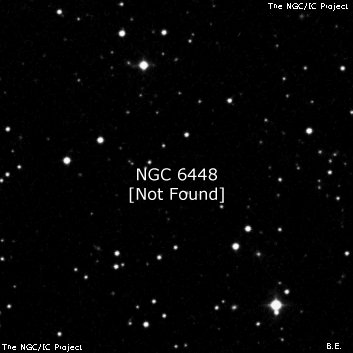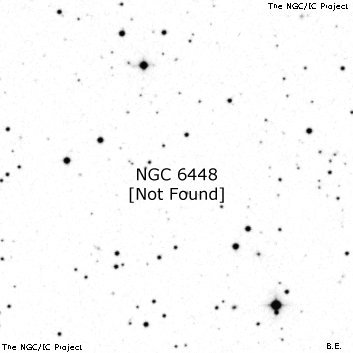NGC/IC Project Restoration Effort
(This is a very very beta version)
NGC6448


Basic Information
Location and Magnitude
Right Ascension: 17:44:20.5
Declination: +53:32:25
Constellation: DRA
Visual Magnitude:
Historic Information
Discoverer: Swift L.
Year of discovery: 1885
Discovery aperture: 16.0
Observational
Summary description: vF, pS, R, lbM
Sub-type: NF
Corwin's Notes
=====
NGC 6448. I had written about this:
NGC 6448 is lost. It is the 60th entry in Swift's second list. Dreyer
copied all of Swift's data exactly and correctly into the NGC. There are no
galaxies in the area that might be Swift's object, and I can't find an
obvious digit error that would lead to another (though I did not check for
large errors, e.g. 10 degrees, 1 hour). Swift found no other nebulae the
night of 16 July 1885, so we have no possible systematic offset to work
from, either.
During preparation of his Visual Atlas of the NGC, Jeffrey Corder suggested
the linear asterism -- one brighter star in a line with three fainter -- as
Swift's object. The RA is about 30 seconds west of Swift's, and the Decs
agree to within half an arcminute. Jeff's own observation with his 17.5-inch
reflector agrees closely with Swift's description ("vF, pS, R, lbM"), but Jeff
notes it as "a little extended in PA = 90 degrees", while Swift made it simply
"round".
The main problem with this asterism is the brightest star in the center -- it
is much brighter than the other three stars. Unless the night Swift found it
was one of poor seeing, I'm doubtful that he would see this as anything but a
star.
This is, nevertheless, the best candidate in the area, so I have put it into
the main table, with the appropriate colons, of course.
Steve's Notes
=====
NGC 6448
18" (8/27/11): At 175x I identified a mag 11.6 star that possibly appeared to have one or more faint companions as there was a slightly hazy glow very near extended E-W. At 393x, three close, very faint companions were resolved; two following and one preceding, with all 4 stars roughly collinear. The two companions to the east are at 17" and 30" from the brighter star, while the companion to the west is at a separation of 19". The brightest of the three faint stars is at the east end, though all three are near V = 15.5. Located 15' S of 5.8-magnitude HD 161693.



